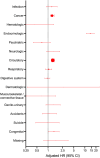Causes of Excess Mortality in Diabetes Patients Without Coronary Artery Disease: A Cohort Study Revealing Endocrinologic Contributions
- PMID: 39247670
- PMCID: PMC11380490
- DOI: 10.2147/CLEP.S463363
Causes of Excess Mortality in Diabetes Patients Without Coronary Artery Disease: A Cohort Study Revealing Endocrinologic Contributions
Abstract
Background: Diabetes mellitus (DM) patients without coronary artery disease (CAD) have a higher all-cause mortality rate than patients with neither DM nor CAD. We examined cause-specific death of DM patients with and without CAD.
Methods: We conducted a cohort study of all patients who underwent CAG in Western Denmark between 2003 and 2016. Using Danish health registries, patients were followed for a maximum of 10 years and stratified according to their DM and CAD status. Outcomes included all-cause-, cancer-, circulatory-, and endocrinologic death. Ten-year cumulative risks were computed as well as adjusted and unadjusted hazard ratios (aHR and HR).
Results: A total of 132,432 patients (28,524 deaths, median follow-up of 6.2 years) were included. Compared to patients with neither DM nor CAD, DM patients without CAD had a higher 10-year risk of all-cause death (27.9% versus 19.7%, aHR 1.43 [95% CI 1.35-1.52]), cancer death (7.2% versus 5.4%, aHR 1.29 [95% CI 1.15-1.46]), circulatory death (9.1% versus 6.9%, aHR 1.35 [95% CI 1.22-1.49]), and endocrinologic death (3.9% versus 0.3%, aHR 14.02 [95% CI 10.95-17.95]). Among endocrinologic deaths, 87% were due to classical complications of DM, such as diabetic nephropathy and ketoacidosis, in DM patients without CAD.
Conclusion: Diabetes patients without CAD exhibit a higher risk of all-cause mortality, driven primarily by elevated rates of cancer, circulatory, and endocrinologic deaths, particularly related to diabetic microvascular complications.
Keywords: coronary artery disease; death; diabetes.
© 2024 Birindwa et al.
Conflict of interest statement
MM is supported by a grant from the Novo Nordisk Foundation (grant number NNF22OC0074083); has received institutional research grants from Bayer and Novo Nordisk; and has received lecture and/or advisory board fees from AstraZeneca, Bayer, Boehringer-Ingelheim, Bristol-Myers Squibb, and Novo Nordisk. He also has an institutional research contract with Philips and Janssen and reports equity interests from Eli Lilly and Verve Therapeutics. KWO has received a research grant from the Danish Cardiovascular Academy. All other authors report no conflicts of interest in this work.
Figures



Similar articles
-
Long-Term Prognostic Utility of Coronary CT Angiography in Stable Patients With Diabetes Mellitus.JACC Cardiovasc Imaging. 2016 Nov;9(11):1280-1288. doi: 10.1016/j.jcmg.2015.12.027. Epub 2016 Aug 24. JACC Cardiovasc Imaging. 2016. PMID: 27568114
-
Peripheral artery disease, lower limb revascularization, and amputation in diabetes patients with and without coronary artery disease: a cohort study from the Western Denmark Heart Registry.BMJ Open Diabetes Res Care. 2021 Jan;9(1):e001803. doi: 10.1136/bmjdrc-2020-001803. BMJ Open Diabetes Res Care. 2021. PMID: 33414173 Free PMC article.
-
Diabetes Mellitus Is Associated With Increased Risk of Ischemic Stroke in Patients With and Without Coronary Artery Disease.Stroke. 2019 Dec;50(12):3347-3354. doi: 10.1161/STROKEAHA.119.026099. Epub 2019 Nov 6. Stroke. 2019. PMID: 31690249
-
Coronary computed tomography angiography as a tool for long-term cardiovascular risk stratification in diabetic patients.Heart Vessels. 2019 Jul;34(7):1086-1095. doi: 10.1007/s00380-018-01339-0. Epub 2019 Jan 11. Heart Vessels. 2019. PMID: 30635712
-
Coronary Artery Disease Is A Stronger Predictor of All-Cause Mortality Than Left Ventricular Ejection Fraction Among Patients With Newly Diagnosed Heart Failure: Insights From the WDHR.J Am Heart Assoc. 2024 Jul 16;13(14):e9771. doi: 10.1161/JAHA.123.033938. Epub 2024 Jul 3. J Am Heart Assoc. 2024. PMID: 38958148 Free PMC article.
References
LinkOut - more resources
Full Text Sources
Miscellaneous

